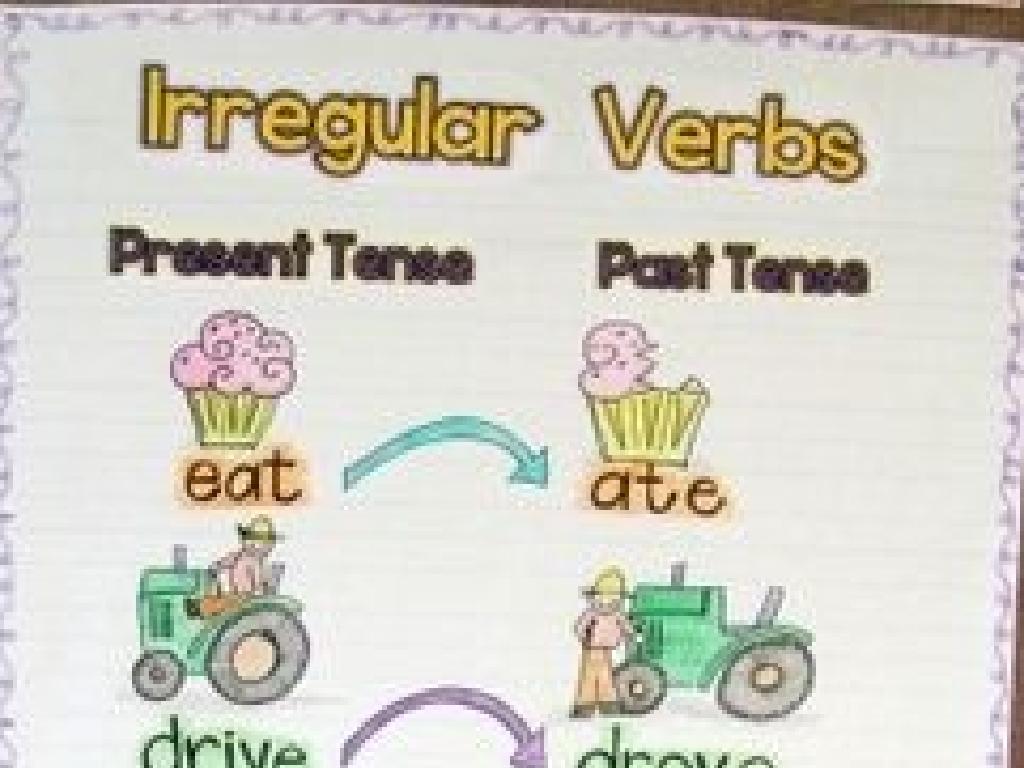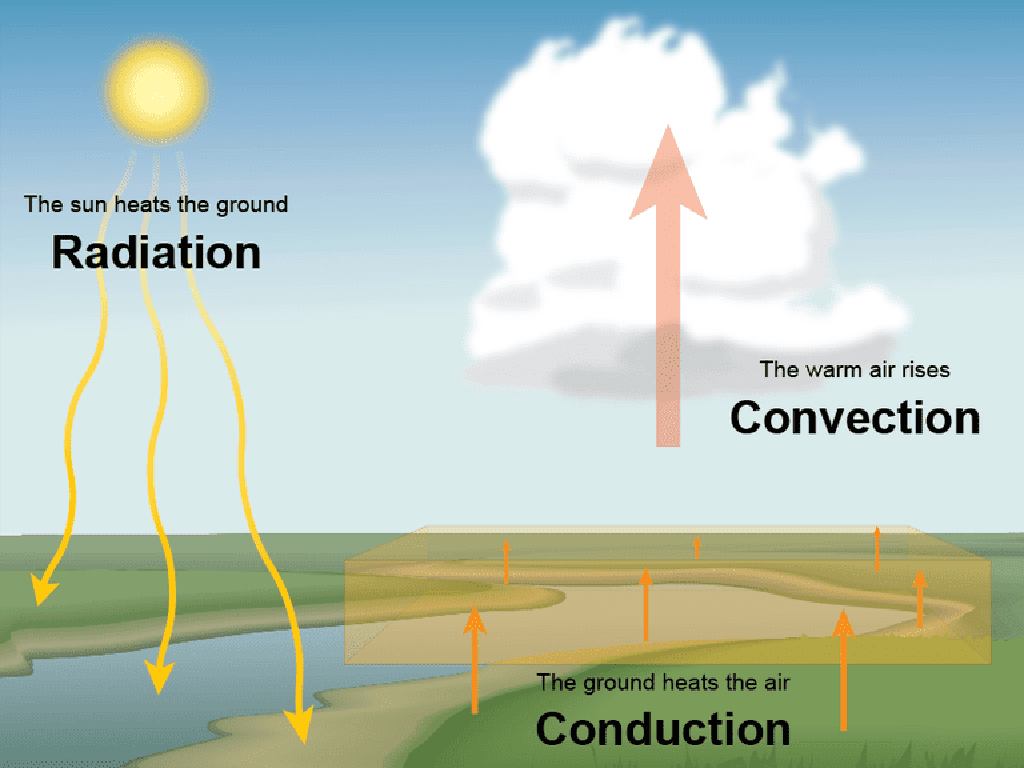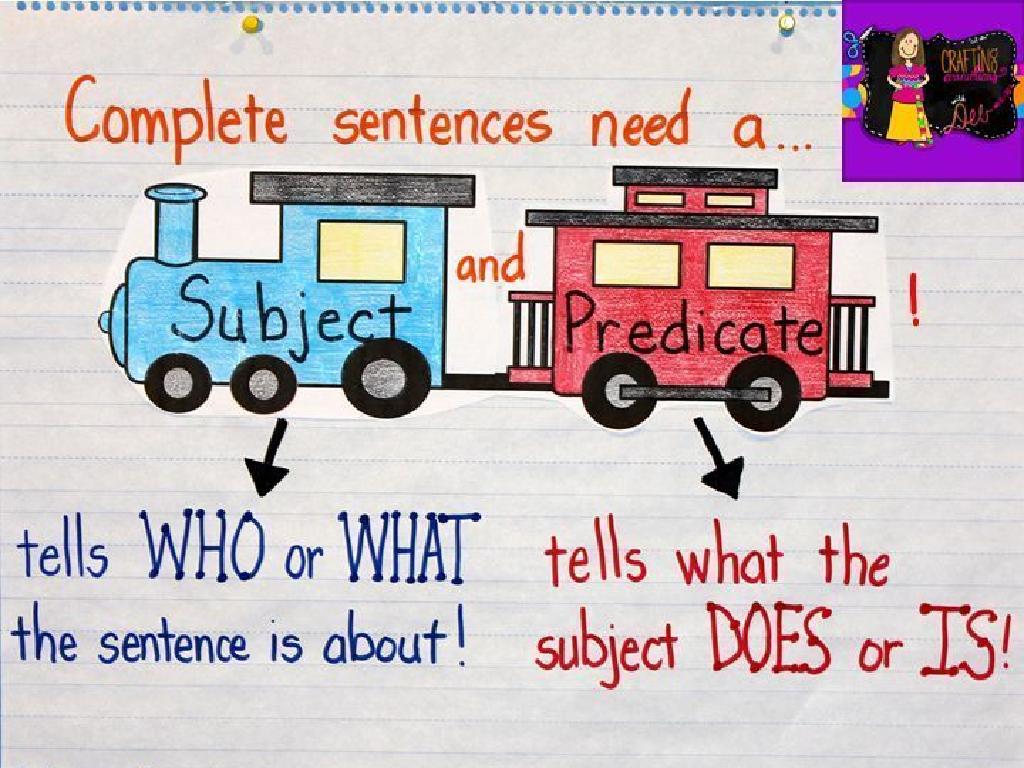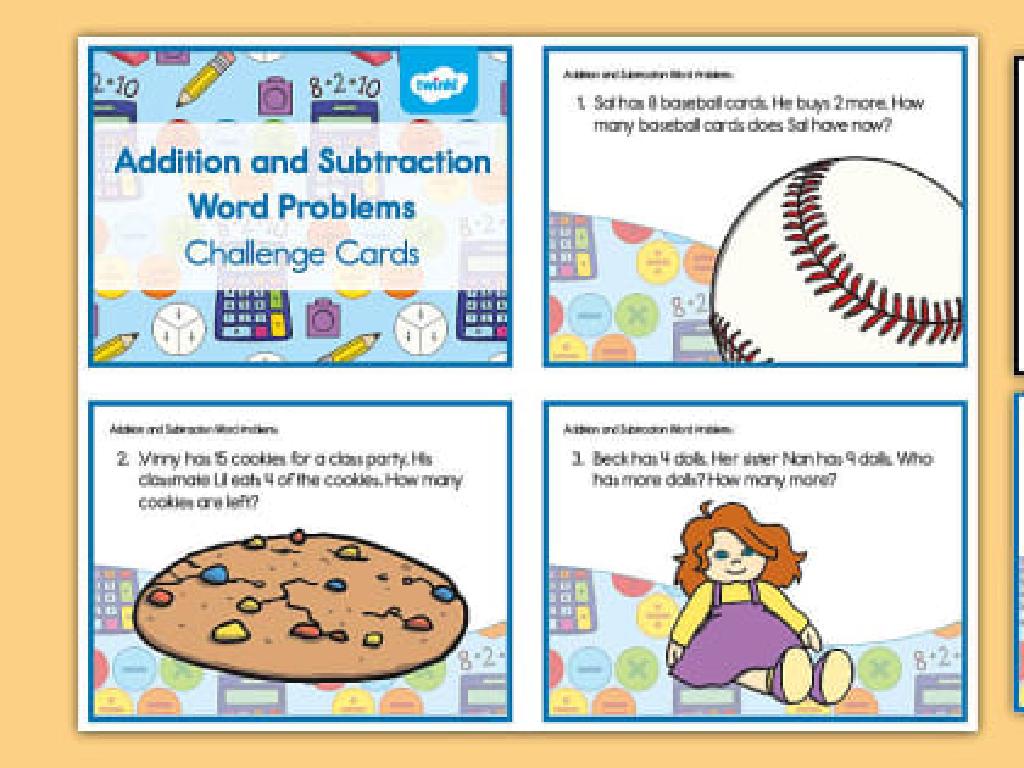Change-Of-State Diagrams: Melting, Freezing, Vaporizing, Condensing, And Sublimating
Subject: Science
Grade: Fifth grade
Topic: Heat And Thermal Energy
Please LOG IN to download the presentation. Access is available to registered users only.
View More Content
Heat and Thermal Energy: Affecting Matter
– What is thermal energy?
– Thermal energy is the total energy of all the particles in an object.
– Heat’s role in changing matter
– Heat can cause matter to change from one state to another.
– Introduction to state changes
– States of matter include solid, liquid, gas, and plasma.
– Exploring change-of-state diagrams
– Diagrams show matter transitioning between states due to heat.
|
Begin the lesson by explaining that thermal energy is related to the movement of particles within an object the more movement, the more thermal energy. Discuss how adding or removing heat can cause matter to change states, such as ice melting into water or water evaporating into steam. Introduce the concept of change-of-state diagrams, which visually represent these transitions. Emphasize that these diagrams are tools for understanding how heat energy affects matter. Prepare to show examples of diagrams in the following slides and explain the processes of melting, freezing, vaporizing, condensing, and sublimating in more detail.
Understanding Heat and State Changes
– Heat defined as energy
– Heat is a form of energy that can be felt as warmth.
– Heat’s role in state changes
– Heat causes matter to change from one state to another, like ice melting into water.
– Common sources of heat
– The Sun, fire, and heaters are examples of heat sources.
– Observing heat in action
|
This slide introduces the concept of heat as a form of energy that is essential for changing the state of matter. Begin by defining heat and discussing how it can be measured and felt. Explain that heat is responsible for melting, freezing, vaporizing, condensing, and sublimating. Provide relatable examples of heat sources that students encounter in their daily lives, such as the warmth from the sun or the heat from a stove. Conduct a simple demonstration, if possible, to show heat in action, like melting chocolate or ice. Encourage students to think of other examples where they have observed heat causing a change in the state of matter.
Exploring States of Matter and Heat Transfer
– Review: Solid, Liquid, Gas
– Heat’s role in state changes
– Heat can make ice melt or water boil
– Examples: Solids, Liquids, Gases
– Ice cubes, flowing water, steam from a kettle
– Class Activity: Identifying States
– Find items in the classroom that are solid, liquid, or gas
|
Begin with a review of the three states of matter: solid, liquid, and gas, ensuring students recall the characteristics of each. Explain how adding or removing heat can cause matter to change states, such as ice melting into water or water vaporizing into steam. Provide relatable examples for each state of matter, like ice cubes (solid), flowing water (liquid), and steam from a kettle (gas). For the class activity, have students identify and list items found in the classroom that represent each state of matter. This will help them apply their knowledge practically and reinforce the concept of states of matter and how heat affects them.
Change-of-State Diagrams: Heat & Matter
– Diagram layout explanation
– Shows how matter changes state with heat or cold
– Identify states & transitions
– Solid, liquid, gas, and transitions: melting, freezing, etc.
– Heat’s role in state changes
– Heat adds or removes energy, causing state changes
– Examples of state transitions
– Water to ice (freezing), ice to water (melting)
|
This slide introduces students to the concept of change-of-state diagrams, which visually represent how different states of matter can transform into one another through the addition or removal of heat. Begin by explaining the layout of the diagram, identifying the different states of matter (solid, liquid, gas) and the transitions between them (melting, freezing, vaporizing, condensing, sublimating). Emphasize the role of heat in these transitions, explaining that adding heat can cause a substance to melt, vaporize, or sublimate, while removing heat can cause it to freeze or condense. Use common examples, such as water transitioning between ice, liquid water, and steam, to help students relate to the concept. Encourage students to think of other examples and to consider how temperature affects the state of various materials in their daily lives.
Melting and Freezing: Phase Changes
– Understanding melting
– Melting is when solid turns to liquid as it warms up.
– Understanding freezing
– Freezing is when liquid turns to solid as it cools down.
– From ice to water and back
An interactive example: observe ice melting into water, then freezing back into ice.
– Observing phase changes
|
This slide introduces students to the concepts of melting and freezing, which are types of phase changes. Melting occurs when a solid absorbs heat and becomes a liquid. Freezing is the opposite process, where a liquid loses heat and becomes a solid. Use an interactive example, such as melting ice cubes in a glass of water and then freezing them again, to visually demonstrate these concepts. Encourage students to touch and see the ice melting and re-freezing to understand the changes in state. Discuss the role of temperature in these processes and how molecules behave differently in solid and liquid states. This activity will help solidify their understanding of phase changes in matter.
Vaporizing and Condensing
– What is vaporization?
– Vaporization is when a liquid turns into a gas.
– Understanding condensation
– Condensation is the opposite; gas becomes a liquid.
– Class experiment setup
– Observing boiling and condensation
– We’ll boil water to see vaporization and watch steam condense.
|
This slide introduces the concepts of vaporization and condensation, which are important parts of the water cycle and have practical applications in daily life. Vaporization occurs when liquid water gains enough energy to become a gas (steam). Condensation is the process where water vapor loses energy and turns back into liquid form. During the class experiment, students will boil water to observe vaporization and then see the steam condense back into water on a cooler surface. This hands-on activity will help solidify their understanding of these processes. Make sure to discuss safety precautions for boiling water and handling hot equipment. Possible activities include measuring the temperature at which water boils, capturing condensed water, and observing the conditions that affect the rate of condensation.
Sublimation and Deposition
– What is sublimation?
– Sublimation is when a solid turns directly into gas, like dry ice becoming CO2 gas.
– Deposition: Sublimation’s opposite
– Deposition is the reverse; gas becomes solid without becoming liquid first.
– Dry ice demonstrates sublimation
– Dry ice sublimates at room temperature, showing the process visibly.
– Safety first with dry ice
– Always handle dry ice with gloves and in well-ventilated areas.
|
This slide introduces students to the concepts of sublimation and deposition, which are less commonly experienced than melting or freezing but equally important. Sublimation occurs when a solid turns directly into a gas without passing through the liquid state, like dry ice turning into carbon dioxide gas. Deposition is the opposite process, where a gas turns into a solid without becoming liquid, like frost forming on a window. Demonstrating with dry ice provides a tangible example, but it’s crucial to emphasize safety precautions, such as using gloves and ensuring the room is well-ventilated to prevent CO2 buildup. Encourage students to observe and describe the process, linking it to the broader topic of state changes in matter.
Applying Heat and Thermal Energy
– Heat energy and state change
– Heat can turn solids to liquids (melting) and liquids to gas (vaporizing).
– Everyday heat transfer
– Notice how ice melts on a warm day or water condenses on a cold glass.
– Predicting heat outcomes
– Guess what happens to water when it’s heated or cooled.
– Experimenting with heat
|
This slide aims to explain how heat energy affects the state of matter. Begin by discussing how adding heat can cause a solid to melt into a liquid, or a liquid to vaporize into a gas. Conversely, removing heat can cause gas to condense into a liquid or a liquid to freeze into a solid. Provide everyday examples of heat transfer, such as ice melting into water or water vapor condensing on a cold surface. Encourage students to predict what happens to substances like water when they are heated or cooled. Finally, plan simple experiments to demonstrate these concepts, such as melting ice cubes or observing condensation, to reinforce learning through practical application.
Class Activity: Change-of-State Race
– Gather materials for the race
– Follow melting race instructions
Use timers to measure how long it takes for ice to melt in warm water.
– Observe and record the ice melting
Write down observations about the ice cube as it changes state.
– Discuss findings with the class
Share what you noticed and learned during the activity.
|
This activity is designed to help students understand the concept of change of state through a hands-on melting race. Provide each group with ice cubes, warm water, cups, and timers. Students will place an ice cube in warm water and use the timer to measure how long it takes to melt completely. They should take notes on the process, observing how the solid ice cube turns into liquid water. After the activity, facilitate a group discussion where students can share their observations and reflect on the factors that might affect the rate of melting. Possible variations of the activity could include using different temperatures of water, comparing with ice melting at room temperature, or even measuring the time it takes for the water to freeze or vaporize under different conditions.
Conclusion: Change-of-State & Heat’s Role
– Recap change-of-state diagrams
– Heat’s impact on state changes
– Heat energy causes particles to move differently, leading to state changes.
– Review key concepts
– Revisit melting, freezing, vaporizing, condensing, and sublimating.
– Engage in Q&A session
|
This slide aims to summarize the lesson on change-of-state diagrams and the role of heat in these processes. Begin by recapping the diagrams, ensuring students can visualize and understand the transitions between states of matter. Emphasize how adding or removing heat can cause matter to change from one state to another, such as ice melting into water or water vapor condensing into dew. Review the key concepts and terms discussed during the lesson, such as melting point and boiling point. Conclude with a Q&A session to address any uncertainties and solidify understanding. Encourage students to ask questions about the material covered and provide examples to clarify complex ideas.






